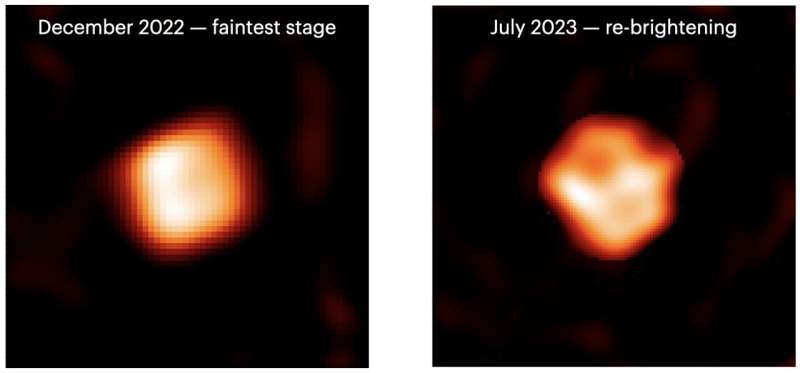This article has been reviewed according to Science X's editorial process and policies. Editors have highlighted the following attributes while ensuring the content's credibility:
fact-checked
peer-reviewed publication
trusted source
proofread
A colossal star erupts: Examining one of the largest stars in the Milky Way as it fades from view

Astronomers from Georgia State University's CHARA Array have captured the first close-up images of a massive star known as RW Cephei that recently experienced a strange fading event. The images are providing new clues about what's happening around the massive star approximately 16,000 light years from Earth.
Detailed images and observations along with intelligent algorithms created by the team of scientists suggest a grand eruption that launched a gas cloud from RW Cephei, blocking a large fraction of starlight from view. Experts from Georgia State's CHARA Array presented the new findings at the 243rd meeting of the American Astronomical Society in New Orleans. The research is published in The Astronomical Journal.
Scientists were surprised last year by the fading of the enormous star, which is an example of a "cool hypergiant," a star that has grown to huge dimensions as it approaches the end of its life. RW Cephei is so large that if it were placed at the sun's location, its outer layers would reach beyond the orbit of Jupiter.
"We made our first CHARA observations in December 2022, just before the winter weather closure, but the results were so remarkable we decided to pursue additional observations once the star was accessible again," said Georgia State University astronomer Narsireddy Anugu, who led an international team of scientists in a quest to make the first close-up pictures of RW Cephei to determine the source of the fading.
Old stars display light variations that are related to changes in their outer layers. The changes are usually small, so scientists were amazed when astronomers Wolfgang Vollmann and Costantino Sigismondi announced in 2022 that RW Cephei had faded dramatically over the previous few years. By December 2022, RW Cephei had faded to about one-third of its normal brightness, an unprecedented drop. Scientists wanted to figure out what was causing this great dimming.
Despite its huge size, RW Cephei is so far away that it appears as a pinpoint even using the largest of conventional telescopes. To see the star close up required the remarkable abilities of the Center for High Angular Resolution Astronomy (CHARA) Array telescopes.
The CHARA Array is a six-telescope facility located at the historic Mount Wilson Observatory in California. The telescopes are placed across the mountaintop to act together like one enormous telescope. The combination of their light beams gives the CHARA Array the ability to see details on very tiny objects in the sky, about 30 times smaller than the largest conventional telescopes, and smaller than a human on the moon as seen from Earth.
The CHARA observations showed that the star did not appear round, as expected, but to make a picture with full details required specialized computer programs created by Georgia State University Associate Professor of Astronomy Fabien Baron.
"The spacing of the CHARA telescopes induces a level of uncertainty in the exact details of the pictures, so we need intelligent algorithms to recover the whole image," Baron said.
The final pictures show a star convulsed by motions in its outer layers that create fainter and brighter patches across its surface. Furthermore, the appearance changed significantly over the 10-month period of observations that coincided with the transition from its faintest state to a slow recovery toward its former brightness.
The final piece of the puzzle came from additional observations of RW Cephei that were made by Georgia State University graduate student Katherine Shepard at the Apache Point Observatory in New Mexico. Shepard used a special camera to record the light from RW Cephei from the visible to the infrared, and these measurements showed that the fading was much larger in the visible colors compared to the infrared. This is a tell-tale sign that the starlight was obscured by microscopic dust clouds blocking our view.
Taken together, the observations suggest that RW Cephei experienced a huge eruption that launched a vast cloud of gas. As the cloud moved away, it cooled and created swarms of dust particles that effectively blocked a large fraction of starlight. Now, as the cloud expands away, we are beginning to see the star again and its troubled surroundings.
CHARA Director Douglas Gies thinks that this may be one of several grand eruptions that have wracked RW Cephei over the last century and that such eruptions will continue to play a role in mass loss before the star's demise.
"This one was special because the cloud was ejected in the direction of Earth, so we were in the right place to witness the full effects of the cataclysm," Gies said.
More information: Narsireddy Anugu et al, The Great Dimming of the Hypergiant Star RW Cephei: CHARA Array Images and Spectral Analysis, The Astronomical Journal (2023). DOI: 10.3847/1538-3881/ace59d
Journal information: Astronomical Journal
Provided by Georgia State University





















